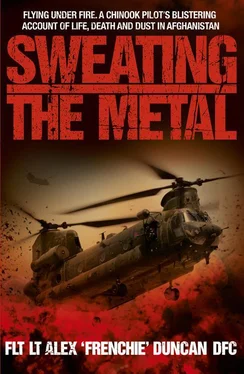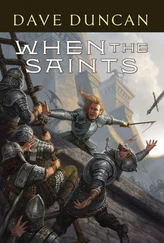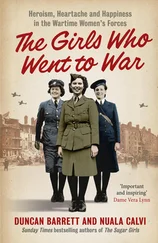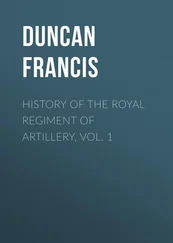‘The engineers told us that the reason we lost the No.1 engine on the first cab was due to mechanical failure in its accessory gearbox. That is quite literally unheard of – something that, as far as we are aware, has never happened before. The accessory gearbox measures the power going into the engine – N1 – and the power coming out of it – N2. Something that simple and it could have caused us to go down. Had it happened an hour or two later in the day, we would probably have lost the aircraft, possibly the whole crew as well. That was a really sobering thought. We didn’t have time to dwell though, and things were about to hot up for us when we responded to another call out at 12:47.
‘We’d been called out for a T1, a British soldier who’d been shot in the neck between Nadi Ali and Marjah – a real No Man’s Land. He was part of a recce team to the south of the Helmand River that was still engaged in an intense firefight with Taliban forces to the north, so our Apache escort told us to hold. I banked away and flew a holding pattern about five miles out, over the desert, so the Taliban wouldn’t hear us and know we were coming.
‘Looking at the map, I saw that our planned route in would take us directly over the enemy firing point to the north. That was an obvious no-no, so I decided to fly the long way round to our casualty, routing due south. I bugged the RadAlt at 10ft and, flying fast and low, used as many trees and compounds as I could find for cover – never the easiest thing to do in a Chinook!
‘With the weight of fire the ground troops were taking, we were never going to have a completely secure LS. My thoughts were confirmed when the Apache pilot eventually said, “Look guys, it’s really bad out there but it’s only going to get worse so we’re going to get you in now. You’re clear in.”
‘That was pretty much a guarantee that we’d take fire on the way in, but there was nothing we could do. I flew directly over the point where Chomper was shot in the head two weeks earlier, so I told Richie to man the port Minigun because we’d be coming in with the enemy on that side. I flew in hard and fast, sticking the aircraft on its nose and booting the tail left and right to scrub off speed at the last second. I came in south of the ground troops with the ramp facing them and touched down as close as I dared to the casualty.
‘The guys were off and on again with the casualty in quick order, but even while they were doing so the ground troops to my right were laying down a ferocious weight of fire to keep the Taliban’s heads down. Despite this, they were still returning fire and Daz, who was on the starboard Minigun, said he had a clear firing solution. I said, “You’re clear to engage,” and he opened up and let them have it with a few long bursts from the Crowd Pleaser. I was flying from the right seat, right in the line of fire, so I told Waldo to follow me through on the controls in case I was hit, and as soon as the ramp came up, I pulled power and lifted.
‘I transitioned away at 10ft as quick and as dirty as I could, with Daz laying down fire on the Minigun and Richie firing from the M60 on the ramp. That was no mean feat, because I was flying evasive manoeuvres and throwing the aircraft all over the sky, but it’s testament to the professionalism of the guys and their training that they were able to keep firing on the targets. They both ranged in on the Taliban firing points and took them out, which was extraordinarily brilliant shooting by them both. I then flew away as fast and as low as I dared. As I departed the area, our Apache loosed off a couple of Hellfire AGM-114N enhanced-blast missiles at the compound where the remaining firing was coming from and it all went quiet, leaving the troops free to tab out a klick or so into a safe area. Thankfully, I got us back to Bastion and our T1 survived, which lifted everyone. It had been a tough mission, the codicil to a day from hell, but it was a mission with a positive outcome all round.’
I had a great time working as an instructor on the OCF, but there was no ignoring the feeling that I was somehow missing out by being away from the cut and thrust of operational flying. Despite the satisfaction of regular flying and more civilised hours that I got from training the next intake of Chinook pilots, I missed being a part of 27 Squadron and all my friends on ‘C’ Flight.
By June 2010, I’d made my decision and set in train the events that led me back to the world I’d left after my 2008 Det. Nothing had changed – same friends, same faces and the same boss – but instead of being there as a training captain, I was now a QHI, meaning I could train, evaluate and sign-off other members of the Flight as training captains. I hit the ground running and went straight into the work-up for ‘C’ Flight’s next tour of duty in Afghanistan. That’s how I found myself on a TriStar bound for Helmand Province once again, when the Flight deployed there at the beginning of October 2010. What follows are extracts from the diaries I kept during that deployment…
OCTOBER 21ST, 2010
What a hard couple of days this has been. Can’t say too much about the job that follows, but it had already been postponed once due to bad weather. Ended up launching a day later than planned. Saw a tornado in the middle of the desert on the way to this US marine base. Absolutely amazing! Anyway, landed in this base at 16:00. We’d spent the whole of the previous two weeks leading up to this mission, a major assault with British troops involving five Chinooks – one formation of two and a formation of three. I ended up as formation leader of the three cabs.
This operation involved more than 800 people in support. There was a US marine battalion of light armoured reconnaissance vehicles on the ground – basically 150 small tanks. Above us there were two Apaches, two Sea Kings with sensors, two A-10 Warthogs, two F-18s, one Compass Call Electronic Warfare Hercules, one Spectre, two Predators and two B-1B bombers; all that to support us. We inserted more than 130 troops.
Took off at 19:00 on one of the darkest nights I’ve ever flown in. Couldn’t even see the ground from low level initially. That was tough, especially as we had to fly low in the Southern Afghan mountains.
We attacked a village next to the Pakistan border. The B-1 bomber dropped six tonnes of bombs on various targets around our landing sites ten minutes before we arrived. We saw the flashes and the massive explosions as 2,000lb bombs hit the ground. Then the A-10s, which have got the biggest air-to-surface gun ever built, strafed our LS three minutes before we landed to explode any IEDs that might have been planted. That was followed one minute later by the Apaches putting missiles in numerous buildings.
Needless to say, we didn’t see even a hint of the enemy during the assault, thank fuck! We disappeared as quickly and stealthily as we arrived. Soon as we cleared the vicinity, the JTAC unleashed hell onto the target area and for thirty minutes jets, helicopters and bombers did his bidding and destroyed the target. Should emphasise that the grid had been observed for weeks and there were no women or children within a country mile. The only people there were all fighting-age males in what was identified as the Taliban’s equivalent of Sandhurst. Great result: thirty-six KIA, loads of drugs destroyed and ten tonnes of explosives captured – enough to make 2,000 IEDs. Two senior Taliban were killed.
We extracted the troops tonight without any problems and flew back to KAF where it’s now 05:00, so I feel fucked.
NOVEMBER 2ND, 2010
Passed my 2,000hrs on the Chinook yesterday. Not in the way I’d have liked though. Was on IRT for 24hrs. Relieved Gez Wyatt and his crew at 08:00, a process that entails us turning up at the back of the aircraft with all our kit at the same time the outgoing IRT crew gets all their kit on its ramp. Once we’re all ready we quickly swap over in case we get a shout just as we’re doing it. We then prepare the aircraft so it’s ready to start at the press of a few buttons.
Читать дальше












